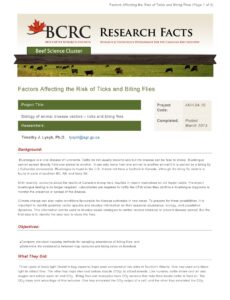Studying Biting Flies that Spread Bluetongue
Bluetongue, a viral disease of ruminants, spreads from one animal to another through a biting fly. Although cattle do not usually become sick from the disease and Bluetongue does not have a strong foothold in Canada, it’s biting fly vectors are found in parts of southern BC, AB, and likely SK. Climate change can make conditions favorable for disease outbreaks in new areas.
To prepare for the possibility of an outbreak, it is important to identify potential vector species and develop information on their seasonal abundance, biology, and population dynamics. This information can be used to develop sound strategies to control vectors and minimize or prevent disease spread. The first step is to identify the best way to study the flies.
A recently-completed research project, funded by the National Check-off and Canada’s Beef Science Cluster, compared standard trapping methods for sampling abundance of biting flies and worked to determine the relationship between trap captures and biting rates on livestock.
Learn more about this research, view the fact sheet.
Click here to subscribe to the BCRC Blog and receive email notifications when new content is posted.
The sharing or reprinting of BCRC Blog articles is welcome and encouraged. Please provide acknowledgement to the Beef Cattle Research Council and list the website address, www.BeefResearch.ca.
We welcome your questions, comments and suggestions. Contact us directly at info@beefresearch.ca or generate public discussion by posting your thoughts below.
Stay connected by following us on Twitter @BeefResearch, liking us on Facebook, and subscribing to our YouTube Channel.
